Home// Articles// Starting a Company// Step-By-Step Guide to Searching for IP
Step-By-Step Guide to Searching for IP
 Tony Kulesa Ph.D.
Principal at Pillar VC
Tony Kulesa Ph.D.
Principal at Pillar VC
Biotech startups’ business value is driven by science and science is… slow. So how do you prove to investors that what you’re building is valuable while keeping your competition at bay? Enter patents, the primary way of defending the time and dollars you’ve invested into R&D.
This is a short guide on how to get started on the basics to answering questions such as: What patents (or applications) are you starting with? What future patents should you file? What is the “whitespace opportunity” in the IP landscape (left unblocked by others) that you will fill?
It is well worth it to hire professional IP counsel to work with you on this (check out our suggestions here), and our intent here is to give you the foundations to best leverage their services
1. What is patentable?
This article is adapted from Pillar VC Partner, Russ Wilcox’s guide, A Primer on Patents.
When starting out you should develop a solid understanding of how patents work.
First, what is patentable? Patents must be:
- Eligible: You can patent processes, machines, articles of manufacture, and compositions of matter (eg a new drug). You cannot patent things naturally occurring in nature, like a protein or metabolite already present in natural systems.
- Useful: The invention must provide a benefit that you can describe.
- Novel: At least one element of your invention was not anticipated by others before, e.g. described in a patent or publication. A prior publication of the idea (even your own!) is considered “prior art” and will knock out your patent, so it is critical to file before you publish or announce your work.
- Non-Obvious: Your invention cannot consist of a group of elements that someone skilled in the art of your field would have anticipated and could readily combine – it has to show ingenuity. This is a somewhat subjective test that varies from examiner to examiner. For a real example of this subjectivity, read the debate of the original CRISPR patents here.
- Enabled: Your disclosure has to be specific enough that people of technical skill in your field also can understand, make, and use the invention without your assistance. That means the invention must have been “reduced to practice” and ideally your patent will provide data to support your claims. That said, some inventors file for a patent while the invention is still on the drawing board, and they only describe how they would build the invention. This is called filing a “paper patent.” Paper patents are easier to file, but are less likely to survive a court challenge.
The key takeaway is that a patent gives you the right to block others, not a license to practice your invention (as others could use their patents to block you). We repeat – patents are fundamentally a defensive mechanism to ward off competitors! Therefore, filing a patent is just the first step in your biotech building journey. For more on this, check out Russ Wilcox’s Guide to Building an IP Fortress.
2. What should you patent?
Consider both your prior work at a university and the technical work you plan on doing as it relates to your final product, i.e. a therapeutic, research tool/instrument or diagnostic.
We worked with Goodwin IP Attorney, Olivia Uitto, to put together this IP and inventions checklist to help you brainstorm core and adjacent patents you should apply for.
Create a list of everything in your planned work that fits the description in this checklist, and consider how you could protect it, e.g. by filing a provisional patent or keeping it as a trade secret.
Generally speaking, patents for a composition of matter (e.g. a chemical compound) are the strongest since you could tangibly obtain and analyze a competitor’s product to prove that they’ve infringed on your invention.
If you cannot prove IP infringement from something externally observable about your competitor’s product, your patent will be much harder to enforce.
Consider an example where you patent a technique for discovering new drug targets. What could you observe about a competitor that shows their infringement? Or consider a patent for repurposing a drug already available on the market to treat a new disease. How hard would it be to identify cases where a physician prescribed the drug off-label, and would you chase down every single one (and risk the negative PR associated)?
Understanding how patents work is important because if your biotech is going to make a big impact, i.e. on the scale of millions or billions of dollars, expect that others will try their best to prove you have infringed on their IP or try to invalidate your patents.
Note: this is not really relevant at the earliest stages — IP lawsuits typically only happen once you’ve been acquired by a larger biopharma company and have the legal budgets to go to court.
3. How to map the IP landscape
Now that you know a little about patents, generate a map of relevant intellectual property in the space you are working. You’ll want to identify a tree of every relevant patent, paper reference, author or date when something is disclosed.
Google Patents is fine as a free patent search tool to get started. We recommend using their “Find Prior Art” tool to help you build out a list of relevant keywords.
Example: Using Google Patent’s “Find Prior Art”

In addition, you should map IP by…
- Reaching out to the tech transfer officer at your university to search through all documented know-how (e.g. patents, applications, and invention disclosures) on their database.
- Creating a list of technical experts in the field (e.g. professors or relevant industry figures), and searching for patents that list them as an inventor.
- Searching scientific literature, especially noting anywhere that patents are listed as a financial conflict of interest.
- Examining patent portfolios of companies in your space (including previous companies that are no longer in business).
- Trying keyword searches of various relevant terms. For example, try combining 3 features of your technology (platform A + platform B + disease area).
- Tracking classification codes listed on patents of interest (e.g. A23L13/00).
- Staying on top of the field via Google Scholar alerts as new patent applications are published.
- Using the patent examiner’s exchange with inventors on relevant patents– specifically the examiner’s search strategy and results – to turbocharge your research. Check out our guide on this in the next section.
In this process, you might expect to find 1,000 references broadly related to your field of interest. Filter for the 100 that are quite relevant. After reading all 100 of these, you’ll have a sense of the ~10 that are most relevant to your invention.
What if you find competing IP?
What happens if you find out about competing IP? Outside of the patent literature, there may also be relevant works already in the public domain. We recommend consulting an IP attorney to get their input when you get into this situation. Don’t panic!
Note: Do not put any of your own assessments or questions of infringement of intellectual property in writing, as this could be discoverable in a future lawsuit unless under attorney-client privilege. Only note its relevance and to bring it up for live discussion.
You may need to obtain a license from another invention for your filing. The earlier you do this the better deal you are likely to get, as you won’t yet have any real value the licensor can extract.
4. Studying the most relevant patents
Once you’ve narrowed the scope to the most relevant patents to your space, we’ll show you how to study a patent in depth.
In this example, we’re analyzing US patent USB703216B2, “Engineered Comestible Meat.”
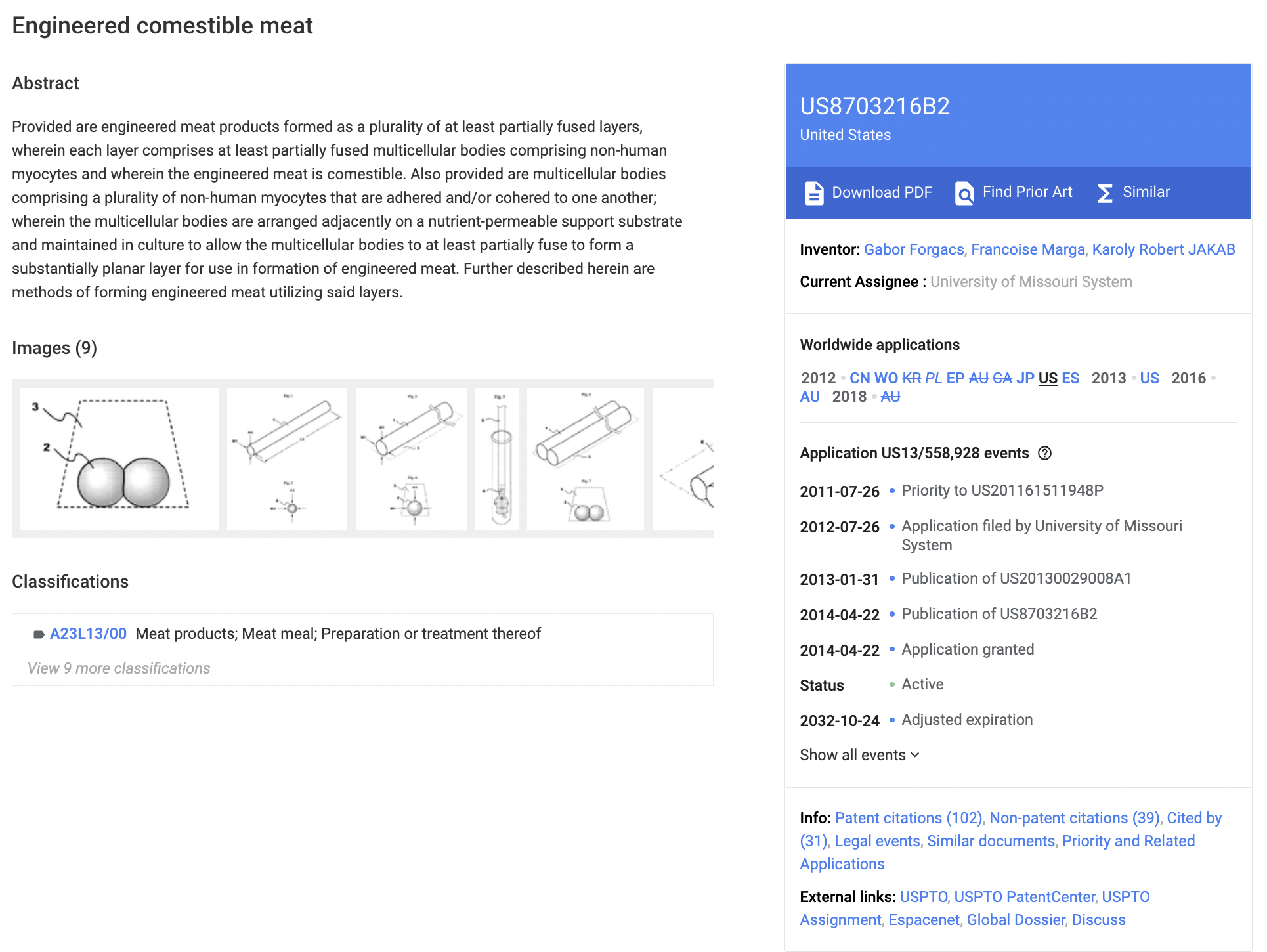
- The abstract reads: “Provided are engineered meat products formed as a plurality of at least partially fused layers, wherein each layer comprises at least partially fused multicellular bodies comprising non-human myocytes and wherein the engineered meat is comestible.”
- This patent has 12 claims – in general, pay attention to whether the patent covers specific substrates, manufacturing processes or applications.
Next, use the application number to search for the patent on the Global Dossier, a database attached to the US Patent and Trade Office (USPTO).
Alternatively, search for the patent on Google Patents and scroll down to the external links section.
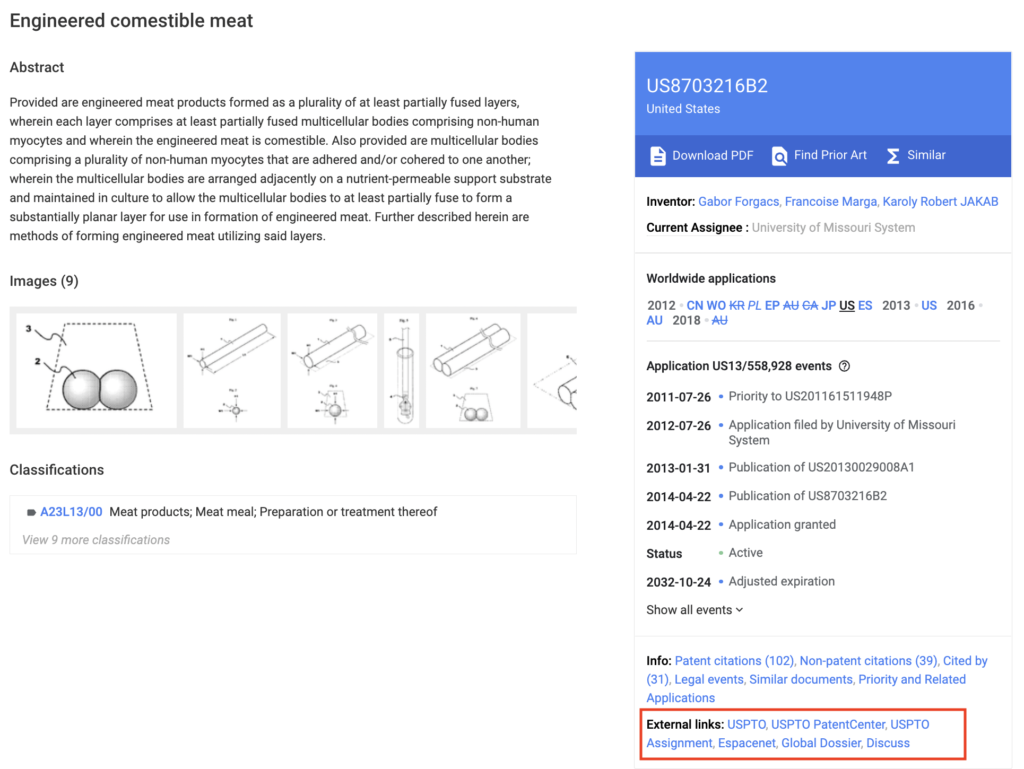
The written communication between inventors and patent examiners are publicly available information.
In this example, ‘Engineered Comestible Meat’, the inventor starts off by submitting 32 claims and ends up with 12 approved by the end of the patent examination process.
Your goal in reading these interactions is to 1) understand the initial claims that were made and how it was refined over time and why; 2) discover related patents identified by the examiner and add those to your search.
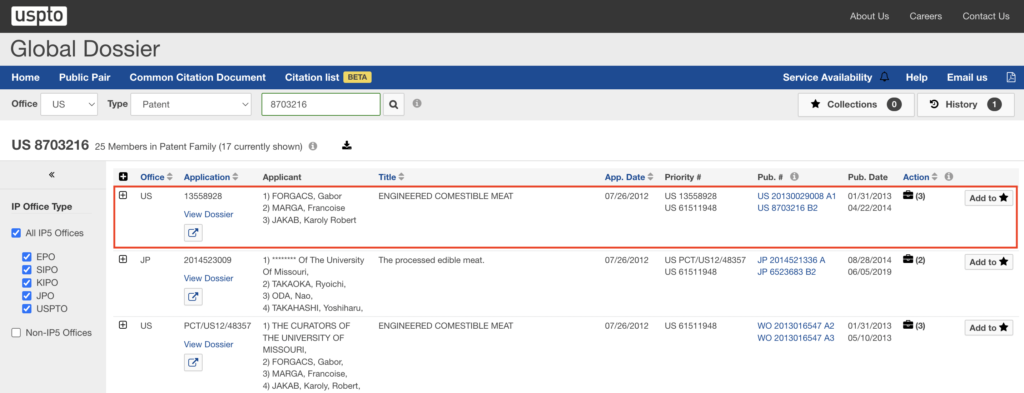
Once you click into the patent, you’ll see a chronological record of the documents that went into the patent application. We recommend scrolling all the way to the bottom to view from the beginning and downloading files to your drive for ease of access.
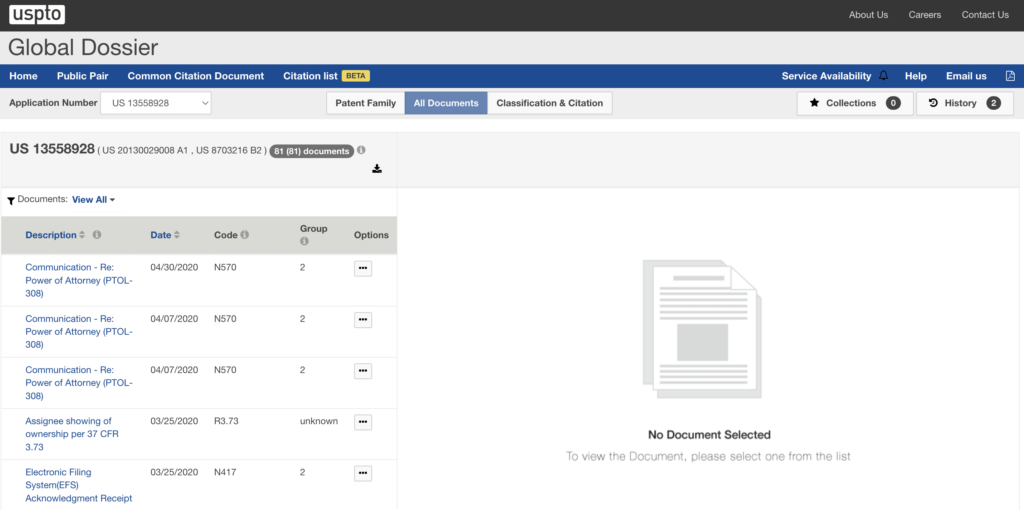
The first document on record is the Transmittal of New Application. You’ll find basic information about the patent, such as the date it was filed (July 26, 2012) and the inventor (Gabor Forgacs).
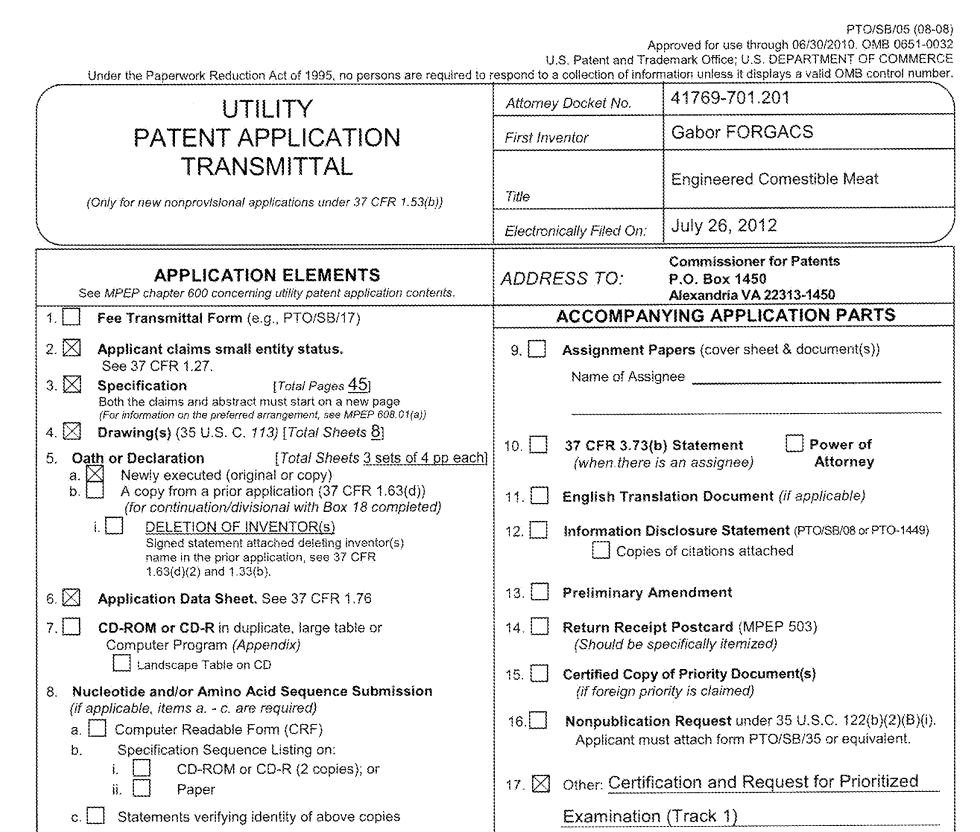
In the Applicant Initiated Interview Summary or the Examiner Initiated Interview Summary, we learn that the patent examiner on this case is agent Jerry W Anderson of Art Unit 1791, application number 13/558,928.
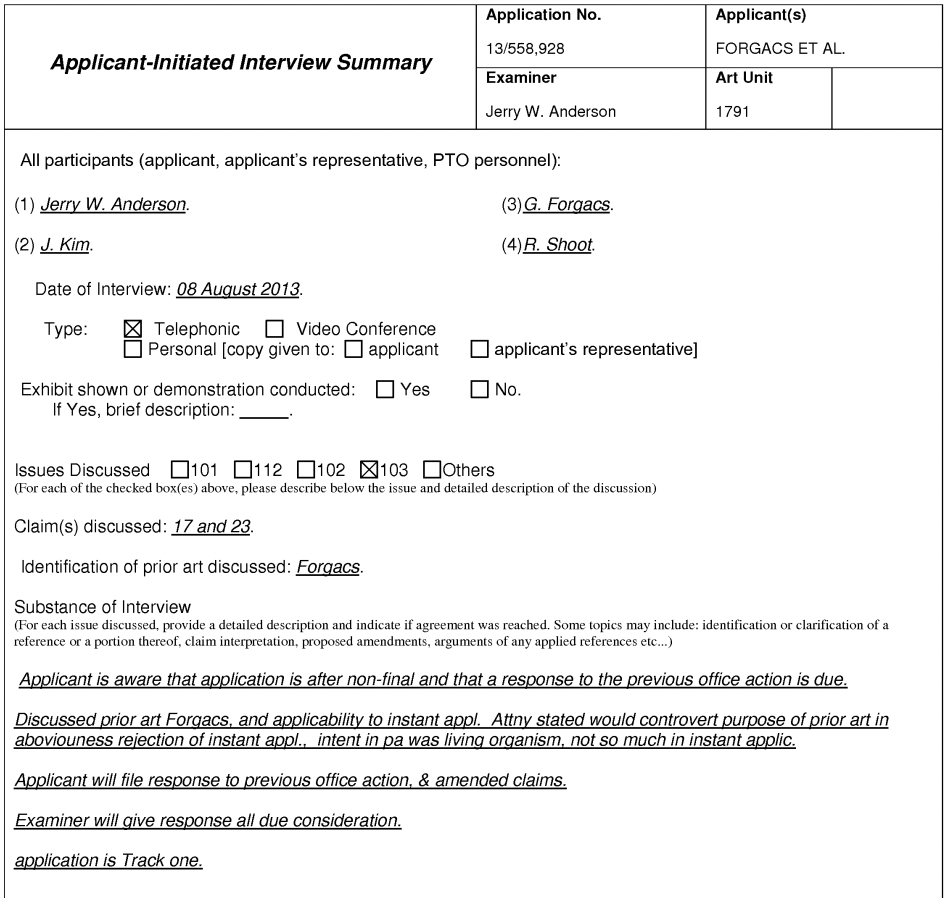
The Claims section describes the back and forth and concessions the inventor agrees to after the patent officer has reviewed their file.
Claims 1-16 were canceled by the inventor after this initial review.
Claim 17 was revised to include details on planar substrate and 20-80 layers.
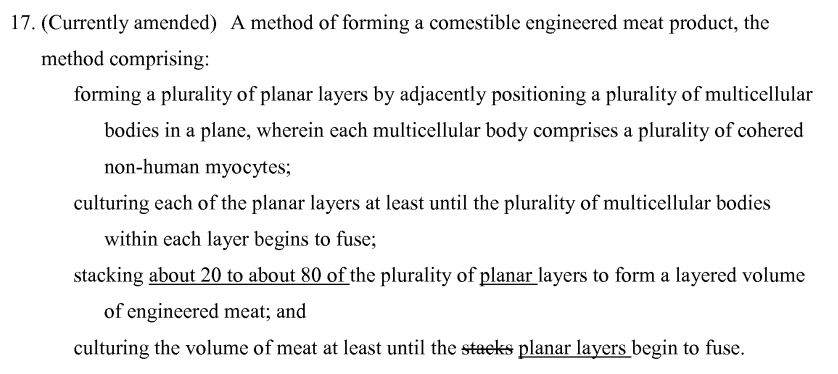
The Non-Final Rejection document tells us why a number of claims are rejected and the prior art that the examiner cites to justify this decision.
We learn that several of Forgacs’ claims are rejected based on obviousness due to a prior publication in 2010: “Self-assembling multicellular bodies and methods of producing a three-dimiensional biological structure using the same” (application number: 2010/0041134).
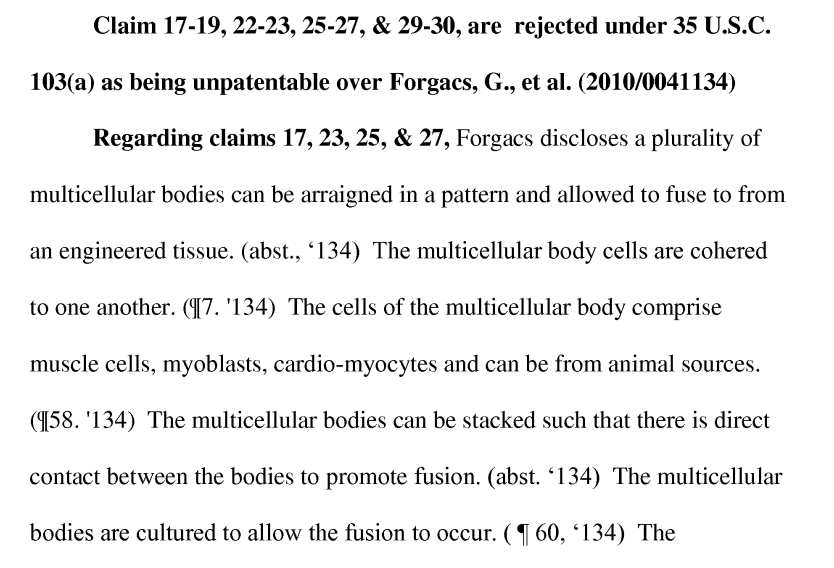
The Examiner’s search strategy and results reveal the list of search queries the patent examiner has used to determine prior art (and their hit rates). Use this as a shortcut when conducting your prior art research!
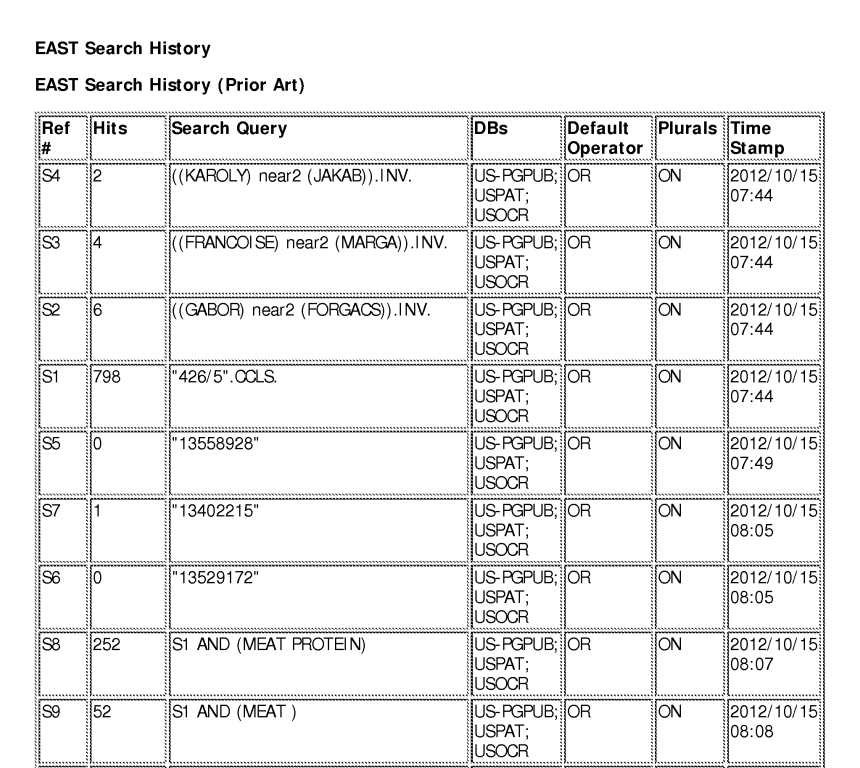
Other documents that are useful in the Global Dossier include Applicant Arguments/Remarks Made in an Amendment and Requirement for Restriction/Election.
In all, this collection of documents weaves together a story of how a patent examiner considers, searches and approves patent applications, and shows the process of how an inventor might respond and reconsider claims in their patent.
Conclusion
We hope this guide helps you become more familiar with IP so you’re prepared heading into discussions with your IP counsel and can be more strategic about choosing a field you’re building in. Remember law firms often offer pro-bono services to early-stage startups before they’ve raised significant funding – ask your university for an introduction or check out the list of counsel we’ve gathered from other biotech founders.
Appendix: Tools to help you map a patent space
- Google Patents: https://patents.google.com/
- USPTO Global Dossier: https://globaldossier.uspto.gov/#/
- USPTO Public Patent Application Information Retrieval: https://portal.uspto.gov/pair/PublicPair
- WIPO Patentscope: https://www.wipo.int/patentscope/en/
- PatentBots.com: https://www.patentbots.com/
- IP and Inventions Checklist – https://docs.google.com/document/d/1yXdoWeVYblxye22yeVw6pw57ssi7SzChUCqfFHzezn8/edit
- The Patent Saavy Executive – https://www.goodwinlaw.com/minisites/patent-savvy-executive-fundamentals



